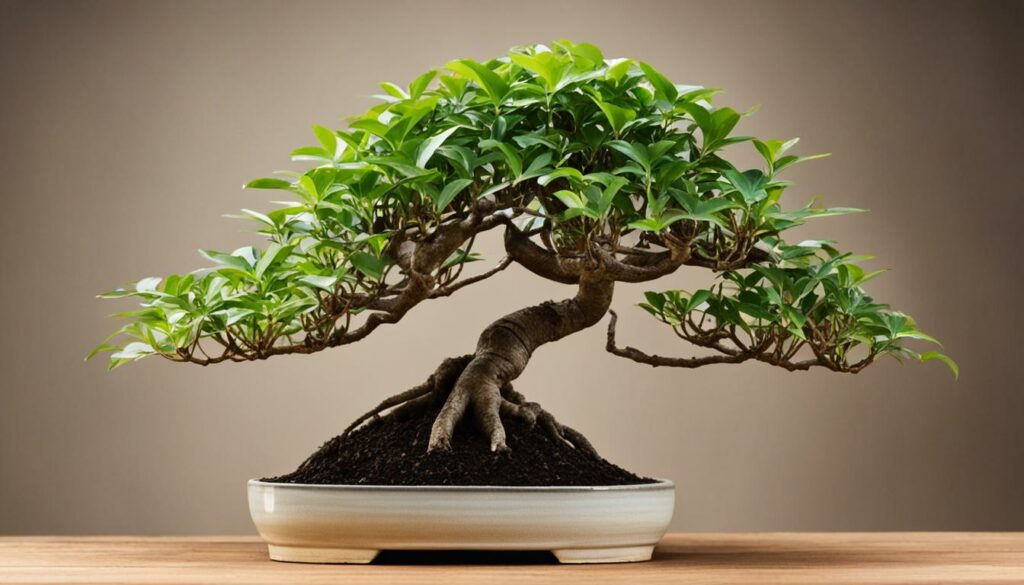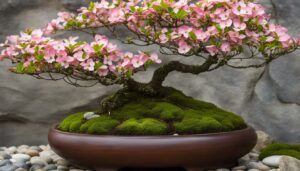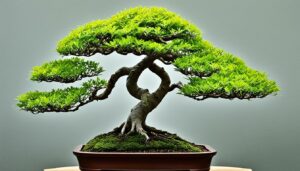You may have heard of the popular indoor plant, the Money Tree. But did you know that it is actually a type of bonsai tree species? The Bonsai Tree Species Money Tree, scientifically called Pachira aquatica, is known for its association with financial fortune and its captivating beauty.
As a braided bonsai, the Money Tree’s unique trunk and glossy green leaves make it an ideal choice for bonsai enthusiasts who seek an aesthetically pleasing and symbolic addition to their home or workspace.
Key Takeaways:
- The Money Tree is a type of bonsai tree species ideal for indoor cultivation.
- Scientifically known as Pachira aquatica, the Money Tree is known for its association with financial fortune.
- The Money Tree’s distinctive braided trunk and glossy green leaves make it an aesthetically pleasing addition to any space.
- Cultivating a Money Tree requires proper care and maintenance, including adequate watering, lighting, and pruning techniques.
- According to Feng Shui beliefs, the Money Tree can bring financial prosperity and positive energy into its owner’s life.
The Fascinating Origins of the Money Tree
The Money Tree, also known as Pachira aquatica, is a popular indoor bonsai tree species highly associated with financial prosperity. Its cultural significance goes back to ancient times, with the belief that the braided trunk of the Money Tree brings good luck and fortune to its owners.
The Native American tribes of Central and South America would often place Money Trees by their homes’ entrances to attract wealth and good energy. The Money Tree’s symbolism of financial fortune and its striking beauty have made it a popular choice for bonsai enthusiasts worldwide.
Discover the origins of the Money Tree and its intriguing history with this bonsai tree species.
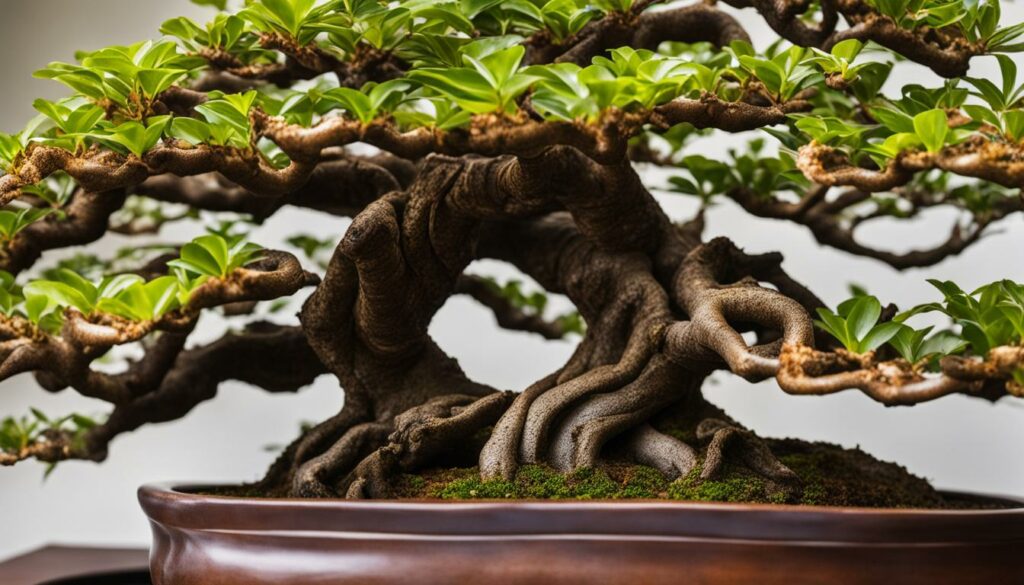
The Origins of the Money Tree
| Country / Region | Cultural Significance |
|---|---|
| Mexico and Guatemala | The braided trunk of the Money Tree symbolizes unity and strength, making it a popular gift at weddings and special occasions. |
| Taiwan and China | The Money Tree is believed to bring good luck and wealth in business, making it a common sight in shops and banks. |
| Thailand | The Money Tree is associated with the goddess of luck and is believed to bring good fortune and wealth to its owners. |
From its origins in Central and South America to its widespread popularity today, the Money Tree’s cultural significance and association with financial prosperity make it a truly captivating bonsai tree species to cultivate.
The Distinctive Features of the Money Tree
The Money Tree is a unique indoor bonsai species that adds a touch of symbolism to any home or workspace. Its distinctive features make it a standout in any room.
Glossy Green Leaves
The Money Tree is known for its luscious, glossy green leaves, which resemble hands reaching out for fortune. These leaves are a distinguishing characteristic of the species and add an exotic touch to its appearance.
Braided Trunk
The braided trunk of the Money Tree adds a touch of artistic flair to its appearance. This adaptation is created by grafting several stem cuttings together to form a unique, beautifully braided trunk that adds a touch of elegance to its already captivating beauty.
If you want your Money Tree to maintain its distinctive features and remain healthy, it is important to care for it properly. This includes providing adequate sunlight, watering it regularly, and ensuring it has well-draining potting soil.
Distinctive Features of the Money Tree
| Feature | Description |
|---|---|
| Glossy Green Leaves | Vibrant green leaves that shine even indoors, giving the look of hands reaching out for fortune. |
| Braided Trunk | A unique adaptation created by grafting several stem cuttings together to form a beautifully braided trunk. |
| Hardy and Easy to Care For | The Money Tree is known for its resilience, thriving in most indoor locations so long as it has adequate light and is watered regularly. |
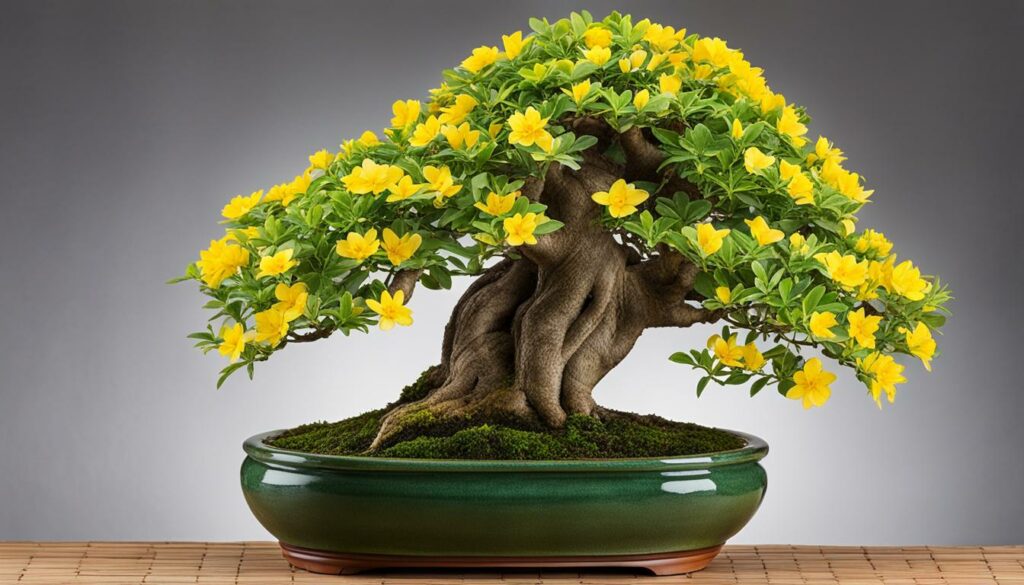
Cultivating Financial Prosperity with the Money Tree
If you are looking for ways to invite financial prosperity into your life, the Money Tree bonsai tree species may be just what you need. According to Feng Shui beliefs, having a Money Tree in your home or workspace can enhance positive energy flow and attract wealth and abundance.
The symbolism behind the Money Tree is believed to be rooted in its feng shui characteristics, including its five braided trunks that represent the five feng shui elements – water, wood, fire, earth, and metal. Together, these elements create a harmonious flow of energy, resulting in financial success and fortune.
To enhance the positive energy and symbolism of your Money Tree, incorporate it into your daily practices and rituals. For example, you can place a red envelope with a coin inside at the base of the tree, symbolizing financial wealth and good fortune. Another practice is to trim the leaves into five groups, each with either six or eight leaves, representing good luck and fortune.
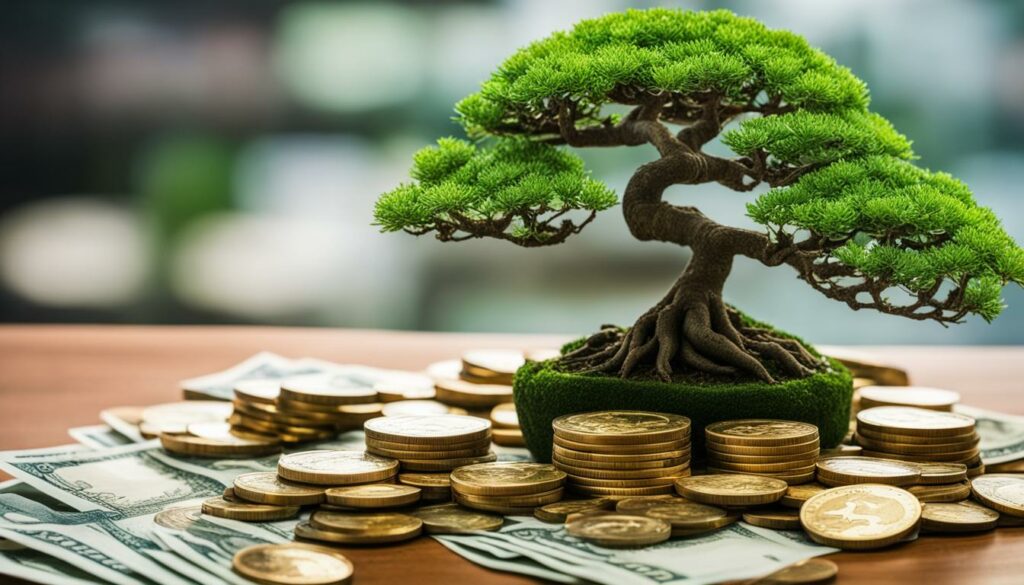
“Harness the symbolization and traditions of this majestic bonsai tree species to unleash its prosperity in your life”
Creating a Serene Indoor Haven with the Money Tree
The Money Tree is not just a symbol of financial prosperity; it can also help create a tranquil environment for your indoor space. The beauty and elegance of the indoor bonsai Money Tree can be used to create a calming and peaceful ambiance.
Incorporate the Money Tree as a centerpiece of your living or workspace to breathe new life into your surroundings. Take advantage of its relaxing effects by adding it to spaces where you want to unwind, such as bedrooms or living rooms.
To create a serene indoor haven with the Money Tree, consider the following:
- Choose the right location for your indoor bonsai, based on lighting requirements that will help it flourish and thrive.
- Select pots and containers that complement your indoor decor and add to the overall appeal of your space.
- Use natural materials such as rocks and stones to enhance the look and feel of your indoor bonsai.
- Don’t overcrowd your space with too many plants, which can create clutter and detract from the peaceful effect you are trying to achieve.
By incorporating the Money Tree into your indoor space, you can create a tranquil environment that soothes the soul and brings a sense of calm to your surroundings.
Nurturing Your Money Tree for Optimal Growth
To ensure your Money Tree thrives and brings financial fortune, proper care and maintenance are crucial. Here are some care tips for nurturing your indoor bonsai:
- Watering: The Money Tree prefers consistently moist soil, but avoid over-watering, which can cause root rot. Water your tree when the topsoil feels dry to the touch, but never let it dry out completely.
- Lighting: Place your Money Tree in a bright spot with indirect sunlight, away from direct heat or cold drafts. Rotate the tree periodically to ensure even growth and leaf distribution.
- Fertilizing: Feed your tree with a balanced liquid fertilizer every two weeks during growing season (late spring to early fall) and reduce frequency during winter.
- Pruning: Regular pruning helps shape your Money Tree and promote healthy growth. Remove dead, damaged, or yellowing leaves and trim unwanted branches or shoots to maintain the desired shape.
- Repotting: Repot your Money Tree every two to three years to provide fresh soil and ensure proper root growth. Use a well-draining soil mixture and a slightly larger pot than the previous one.
By following these care tips, your Money Tree can thrive and bring financial and aesthetic benefits to your home or workspace.
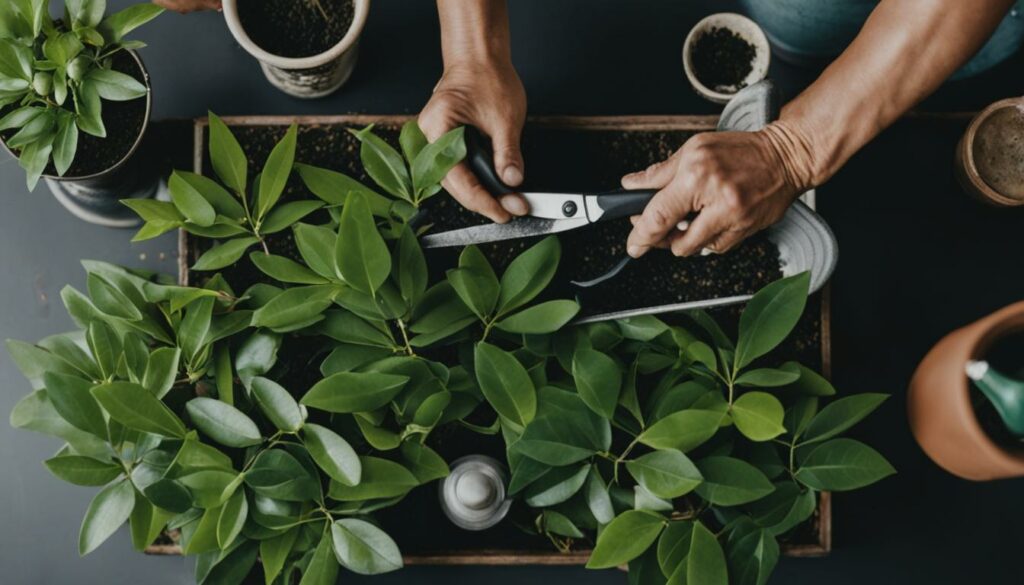
Styling and Pruning Techniques for the Money Tree
Shaping and styling your Money Tree is important not only for visual appeal but also for its overall health. Proper pruning and styling techniques can help create a balanced structure and encourage new growth.
Pruning Techniques
When pruning your Money Tree, it’s essential to use clean and sharp tools to avoid damaging the tree. Start by removing any dead, diseased, or damaged branches, cutting them off at the base of the stem. To encourage growth and thicken branches, pinch off new growth at the tip and trim off any overcrowded or crossing branches. Remember to keep the tree’s natural shape and avoid over-pruning, as it can weaken the tree and impact its overall health.
Styling Techniques
Styling your Money Tree can be a creative process that allows you to showcase a unique and beautiful bonsai tree species. The wiring technique is the most common way to shape and style your tree, making it easier to train your tree’s branches and create a specific design. Start by wrapping the wire around the branches you want to shape, being careful not to cut or damage the bark. Twist in the wire to adjust the branch’s angle and create the desired shape. Additionally, leaf manipulation techniques can be done by pinching off leaves to encourage new growth, or even gently pulling leaves to expose more of the salient features of the Money Tree.
Common Styling and Pruning Techniques for the Money Tree
| Technique | Description |
|---|---|
| Wiring | The process of using copper wire to bend the tree’s branches into the desired shape; use caution to avoid damaging or breaking the branches |
| Pinching | The process of removing the tips of new growth to encourage branching and denser foliage |
| Leaf manipulation | The process of manipulating the tree’s leaves to expose its distinctive features and shape; gentle leaf pulling and removal of overlapping leaves. |
| Pruning | The process of removing dead, diseased, and overcrowded branches to promote plant health and encourage new growth. |
By combining different pruning and styling techniques, you can create a visually captivating Money Tree specimen that showcases all its unique features. Nonetheless, styling techniques require patience, observation, and the right tools, but the results are always rewarding to bonsai enthusiasts.
Exploring Varieties and Adaptations of the Money Tree
As a bonsai tree species, the Money Tree has a wide range of adaptations and cultivars. Each variety has unique features and characteristics, making it a captivating and versatile option for enthusiasts to explore.
One popular adaptation of the Money Tree is the variegated version. These varieties have leaves with a blend of green and yellow pigments creating an eye-catching display. Another modification of this popular bonsai tree species is the braided version, where several trunks are intertwined to form a striking, sturdy trunk.
Some Money Tree varieties, such as the Guiana Chestnut variety, feature a thick, knobby trunk, with a spiraled shape. This striking feature only accentuates the tree’s beauty and makes it a center of attraction.
The Table below showcases some of the most popular adaptations of the Money Tree species:
| Money Tree Varieties | Description |
|---|---|
| Variegated Money Tree | A striking variety with leaves showing a mix of green and yellow pigments. |
| Braided Money Tree | A bonsai tree species featuring multiple trunks intertwined to create an alluring twisted design. |
| Guiana Chestnut | A Money Tree with a thick, knobby trunk and spiral-shaped branches. |
| Pink and Purple Money Tree | A unique cultivar that produces pink and purple leaves throughout the year. |
| Trunk Money Tree | A bonsai tree species featuring a thick, sturdy trunk that forms an impressive centerpiece. |
The Money Tree species offers an array of adaptations and cultivars to choose from, giving bonsai enthusiasts the flexibility to select one that aligns with their unique tastes and preferences.
Overcoming Challenges in Money Tree Cultivation
Cultivating a healthy and thriving Money Tree can sometimes be challenging, even for the most experienced bonsai enthusiasts. Understanding these common challenges and how to overcome them can help ensure the longevity and overall health of your bonsai.
Pest Control
One of the most common challenges in maintaining a healthy Money Tree is dealing with pests. Common pests that can affect the Money Tree include spider mites and scale insects. These pests can cause damage to the leaves and bark of the bonsai, leading to stunted growth or even death.
To prevent pests from invading your Money Tree, consider regularly inspecting the leaves, stems, and bark for signs of infestation. Use a gentle solution of soapy water to remove any visible pests, and consider using insecticidal soap for severe infestations.
Diseases
Another challenge that bonsai enthusiasts may encounter with their Money Tree is plant diseases, such as root rot or fungal infections. These diseases can be caused by overwatering, poor drainage, or improper soil conditions.
To prevent diseases from affecting your Money Tree, ensure that your bonsai is placed in an area with proper air circulation and that the soil is well-draining. Avoid overwatering, and ensure that the soil is slightly damp, but not waterlogged.
Environmental Factors
The growth of a Money Tree can also be affected by environmental factors, such as temperature and lighting. Money Trees are tropical plants and require warm temperatures and high humidity to thrive. They also prefer bright, indirect light, but can tolerate low-light conditions.
To ensure that your Money Tree is in an ideal environment, consider providing supplemental humidity with a humidifier or pebble tray. If growing your bonsai indoors, ensure that it is placed in a well-lit area away from direct sunlight or harsh artificial lighting sources.
Bonsai Training and Maintenance
Proper bonsai training and maintenance are also essential for ensuring healthy Money Tree growth. This includes regular pruning, wiring, and repotting.
When pruning, ensure that you are only removing dead or damaged branches and leaves. Wiring should be done carefully, as damage to the trunk or branches can affect tree growth. Repotting should only be done when necessary and during the spring or early summer months.
By understanding and anticipating these common challenges, you can ensure the successful cultivation of your Money Tree bonsai. With proper care and maintenance, your tree can grow into a stunning centerpiece of your indoor space for years to come.
Conclusion
The Money Tree bonsai tree species is a wonderful addition to any indoor space, not just for its striking appearance but also for its association with financial fortune. By following the guidelines for care and pruning, you can help your indoor bonsai thrive and bring positivity into your life.
Whether you are a beginner bonsai enthusiast or an experienced gardener, the Money Tree offers endless possibilities for styling, pruning, and adaptation. As you explore the vast range of species and cultivars, you will discover the beauty and allure of this captivating bonsai tree.
Incorporating the Money Tree into your indoor environment will not only enhance its appearance but also help create a serene and peaceful atmosphere. Its glossy green leaves and braided trunk provide a calming effect that can help alleviate stress and anxiety.
Thank you for taking the time to read about the captivating world of bonsai trees and the exquisite Money Tree. We hope that you have gained valuable insights into its origins, features, and care requirements. Embrace the beauty of indoor bonsai and watch as it brings positivity and tranquility into your life.
FAQ
What is a Money Tree bonsai?
A Money Tree bonsai is a miniature version of the Pachira aquatica tree, commonly known as the Money Tree. It is popular among bonsai enthusiasts for its braided trunk and glossy green leaves, believed to bring financial fortune.
How do I care for a Money Tree bonsai?
To care for a Money Tree bonsai, place it in a well-lit area away from direct sunlight and water it thoroughly when the top layer of soil feels dry. Maintain a consistent watering schedule and use a well-draining soil mix. Prune the branches and roots as needed to maintain its shape and repot the bonsai every 1-2 years.
What is the symbolism of a Money Tree bonsai?
In Feng Shui, the Money Tree bonsai is believed to invite wealth, prosperity, and good luck into the surroundings. It is a symbol of financial abundance and is often placed in homes and offices to enhance positive energy.
Can I keep a Money Tree bonsai indoors?
Yes, the Money Tree bonsai is well-suited for indoor cultivation. It thrives in bright, indirect light and can be kept in a well-ventilated room with a temperature range of 65-75°F (18-24°C). It is important to provide proper care, including regular watering and occasional misting.
How long does a Money Tree bonsai live?
With proper care and maintenance, a Money Tree bonsai can live for several decades. Indoor bonsai trees have a longer lifespan compared to their outdoor counterparts. Regular pruning, repotting, and providing the necessary growing conditions can ensure the longevity of your Money Tree bonsai.
